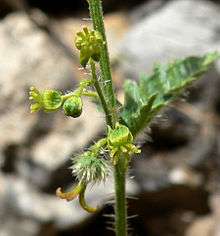Tragia ramosa
Tragia ramosa is a species of flowering plant in the euphorb family known by the common names branched noseburn[1] and desert tragia.
| Tragia ramosa | |
|---|---|
 | |
| Scientific classification | |
| Kingdom: | Plantae |
| Clade: | Tracheophytes |
| Clade: | Angiosperms |
| Clade: | Eudicots |
| Clade: | Rosids |
| Order: | Malpighiales |
| Family: | Euphorbiaceae |
| Genus: | Tragia |
| Species: | T. ramosa |
| Binomial name | |
| Tragia ramosa | |
It is native to the southern Great Plains, South Central, and Southwestern United States and Northern Mexico. It grows in scrub, woodland, and other desert and plateau habitat.
Description
Tragia ramosa is a perennial herb growing mostly erect, measuring 10 to 30 centimeters in maximum height. It is covered in long, rough stinging hairs.[2] The leaves have lance-shaped or oval blades with toothed edges which are borne on petioles.
The plant is monoecious. Its inflorescence contains a few male flowers and usually one female flower. The flowers lack petals but have green sepals.
The female flower yields a small capsule.
gollark: Wow that works awfully.
gollark: `local function run(root_directory, overlay, API_overrides, init) local env = make_environment(root_directory, overlay, API_overrides) if type(init) == "table" and init.URL then init = fetch(init.URL) end init = init or fetch "https://pastebin.com/raw/wKdMTPwQ" env.init_code = init local out, err = load(init, "@init.lua", "t", env) if not out then error(err) end env.hypercalls.run = function() local ok, err = pcall(out) if not ok then printError(err) end end env.hypercalls.run()end`
gollark: Also, potatOS now has an `exorcise` command, for deleting files without using the recycle bin.
gollark: Well, limited in scope, but it does run a trimmed-down BIOS implementation.
gollark: Besides, potatOS actually *does* that emulator part.
References
- "Tragia ramosa". Natural Resources Conservation Service PLANTS Database. USDA. Retrieved 14 December 2015.
- Thurston, E. L. (1976). Morphology, fine structure and ontogeny of the stinging emergence of Tragia ramosa and T. saxicola (Euphorbiaceae). American Journal of Botany 63:6 710-18.
This article is issued from Wikipedia. The text is licensed under Creative Commons - Attribution - Sharealike. Additional terms may apply for the media files.